MNIST - Model induction
MNIST - handwritten digits/Model induction
We shall analyse this dataset using the NISTPy repository which depends on the AlignmentRepaPy repository.
Sections
Model 5 - 15-fud square regions of 10x10 pixels
Model 6 - Square regions of 10x10 pixels
Model 21 - Square regions of 15x15 pixels
Model 10 - Centred square regions of 11x11 pixels
Model 24 - Two level over 10x10 regions
Model 25 - Two level over 15x15 regions
Model 26 - Two level over centred square regions of 11x11 pixels
Model 36 - Conditional level over 15-fud
Model 37 - Conditional level over all pixels
Model 38 - Conditional level over averaged pixels
NIST conditional over square regions
Model 43 - Conditional level over square regions of 15x15 pixels
Model 40 - Conditional level over two level over 10x10 regions
Model 41 - Conditional level over two level over 15x15 regions
Model 42 - Conditional level over two level centred square regions of 11x11 pixels
Model 1 - 15-fud
Consider a 15-fud induced model of 7500 events of the training sample. We shall run it in the interpreter,
from NISTDev import *
(uu,hrtr) = nistTrainBucketedIO(2)
digit = VarStr("digit")
vv = uvars(uu)
vvl = sset([digit])
vvk = vv - vvl
hr = hrev([i for i in range(hrsize(hrtr)) if i % 8 == 0],hrtr)
(wmax,lmax,xmax,omax,bmax,mmax,umax,pmax,fmax,mult,seed) = (2**10, 8, 2**10, 10, (10*3), 3, 2**8, 1, 15, 1, 5)
(uu1,df) = decomperIO(uu,vvk,hr,wmax,lmax,xmax,omax,bmax,mmax,umax,pmax,fmax,mult,seed)
This runs in Python 3.5 64-bit on a Ubuntu 16.04 Intel(R) Xeon(R) Platinum 8175M CPU @ 2.50GHz in 1419 seconds.
summation(mult,seed,uu1,df,hr)
# (140030.31386191736, 69011.41886741124)
len(dfund(df))
152
len(fvars(dfff(df)))
552
open("NIST_model1.json","w").write(decompFudsPersistentsEncode(decompFudsPersistent(df)))
Imaging the fud decomposition,
pp = treesPaths(hrmult(uu1,df,hr))
rpln([[hrsize(hr) for (_,hr) in ll] for ll in pp])
# [7500, 2584, 1039]
# [7500, 2584, 1543, 812]
# [7500, 4815, 1869, 642]
# [7500, 4815, 1869, 1207, 686]
# [7500, 4815, 2919, 1263, 858]
# [7500, 4815, 2919, 1545, 622]
file = "NIST.bmp"
bmwrite(file,ppbm(uu,vvk,28,2,2,pp))

The bitmap helper function, ppbm, is defined in NISTDev,
def ppbm(uu,vvk,b,c,d,pp):
kk = []
for ll in pp:
jj = []
for ((_,ff),hrs) in ll:
jj.append(bmborder(1,bmmax(hrbm(b,c,d,hrhrred(hrs,vvk)),0,0,hrbm(b,c,d,qqhr(d,uu,vvk,fund(ff))))))
kk.append(bminsert(bmempty((b*c)+2,((b*c)+2)*max([len(ii) for ii in pp])),0,0,bmhstack(jj)))
return bmvstack(kk)
Both the averaged slice and the fud underlying are shown in each image to indicate where the attention is during decomposition.
Model 2 - 15-fud
Now consider a similar model but with a larger shuffle multiplier, mult,
from NISTDev import *
(uu,hrtr) = nistTrainBucketedIO(2)
digit = VarStr("digit")
vv = uvars(uu)
vvl = sset([digit])
vvk = vv - vvl
hr = hrev([i for i in range(hrsize(hrtr)) if i % 8 == 0],hrtr)
(wmax,lmax,xmax,omax,bmax,mmax,umax,pmax,fmax,mult,seed) = (2**10, 8, 2**10, 10, (10*3), 3, 2**8, 1, 15, 3, 5)
(uu1,df) = decomperIO(uu,vvk,hr,wmax,lmax,xmax,omax,bmax,mmax,umax,pmax,fmax,mult,seed)
This runs in Python 3.5 64-bit on a Ubuntu 16.04 Intel(R) Xeon(R) Platinum 8175M CPU @ 2.50GHz in 1507 seconds.
summation(mult,seed,uu1,df,hr)
# (137828.7038275605, 68687.36371089712)
len(dfund(df))
134
len(fvars(dfff(df)))
515
open("NIST_model2.json","w").write(decompFudsPersistentsEncode(decompFudsPersistent(df)))
Imaging the fud decomposition,
pp = treesPaths(hrmult(uu1,df,hr))
rpln([[hrsize(hr) for (_,hr) in ll] for ll in pp])
# [7500, 2584, 1043]
# [7500, 2584, 1540, 602]
# [7500, 4619, 1575, 672]
# [7500, 4619, 2966, 1157, 609]
# [7500, 4619, 2966, 1804, 813]
# [7500, 4619, 2966, 1804, 986, 583]
file = "NIST.bmp"
bmwrite(file,ppbm(uu,vvk,28,2,2,pp))
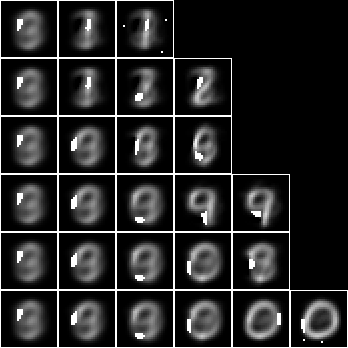
Both the averaged slice and the fud underlying are shown in each image to indicate where the attention is during decomposition.
Model 35 - All pixels
Now consider a compiled inducer. NIST_model35.json is induced by NIST_engine35.py. The sample is the entire training set of 60,000 events.
NIST_engine35 may be run as follows (see README) -
python3 NIST_engine35.py >NIST_engine35.log 2>&1
The first section loads the sample,
(uu,hr) = nistTrainBucketedIO(2)
digit = VarStr("digit")
vv = uvars(uu)
vvl = sset([digit])
vvk = vv - vvl
Then the parameters are defined,
model = "NIST_model35"
(wmax,lmax,xmax,omax,bmax,mmax,umax,pmax,fmax,mult,seed) = (2**11, 8, 2**10, 30, (30*3), 3, 2**8, 1, 127, 1, 5)
The engine runs in Python 3.5 64-bit on a Ubuntu 16.04 Intel(R) Xeon(R) Platinum 8175M CPU @ 2.50GHz using 2623MB in 24991 seconds.
Then the decomper is run,
(uu1,df1) = decomperIO(uu,vvk,hr,wmax,lmax,xmax,omax,bmax,mmax,umax,pmax,fmax,mult,seed)
The decomper is defined in NISTDev,
def decomperIO(uu,vv,hr,wmax,lmax,xmax,omax,bmax,mmax,umax,pmax,fmax,mult,seed):
return parametersSystemsHistoryRepasDecomperMaxRollByMExcludedSelfHighestFmaxIORepa(wmax,lmax,xmax,omax,bmax,mmax,umax,pmax,fmax,mult,seed,uu,vv,hr)
Then the model is written to NIST_model35.json,
open(model+".json","w").write(decompFudsPersistentsEncode(decompFudsPersistent(df1)))
The summed alignment and the summed alignment valency-density are calculated,
(a,ad) = summation(mult,seed,uu1,df1,hr1)
print("alignment: %.2f" % a)
print("alignment density: %.2f" % ad)
The statistics are,
model cardinality: 4040
train size: 7500
alignment: 132688.71
alignment density: 64806.34
Finally the images are written out,
pp = treesPaths(hrmult(uu1,df1,hr1))
bmwrite(model+".bmp",ppbm2(uu,vvk,28,1,2,pp))
bmwrite(model+"_1.bmp",ppbm(uu,vvk,28,1,2,pp))
bmwrite(model+"_2.bmp",ppbm(uu,vvk,28,2,2,pp))
where the bitmap helper functions are defined in NISTDev,
def ppbm(uu,vvk,b,c,d,pp):
kk = []
for ll in pp:
jj = []
for ((_,ff),hrs) in ll:
jj.append(bmborder(1,bmmax(hrbm(b,c,d,hrhrred(hrs,vvk)),0,0,hrbm(b,c,d,qqhr(d,uu,vvk,fund(ff))))))
kk.append(bminsert(bmempty((b*c)+2,((b*c)+2)*max([len(ii) for ii in pp])),0,0,bmhstack(jj)))
return bmvstack(kk)
def ppbm2(uu,vvk,b,c,d,pp):
kk = []
for ll in pp:
jj = []
for ((_,ff),hrs) in ll:
jj.append(bmborder(1,hrbm(b,c,d,hrhrred(hrs,vvk))))
kk.append(bminsert(bmempty((b*c)+2,((b*c)+2)*max([len(ii) for ii in pp])),0,0,bmhstack(jj)))
return bmvstack(kk)

Now with the fud underlying superimposed on the averaged slice,

Model 34 - Averaged pixels
The pixel variables can be averaged as well as bucketed to reduce the dimension from 28x28 to 9x9. The NIST_model34.json is induced by NIST_engine34.py. The sample is the entire training set of 60,000 events. The first section loads the sample,
(uu,hr) = nistTrainBucketedAveragedIO (8,9,0)
The parameters are defined,
model = "NIST_model34"
(wmax,lmax,xmax,omax,bmax,mmax,umax,pmax,fmax,mult,seed) = (2**11, 8, 2**10, 30, (30*3), 3, 2**8, 1, 127, 1, 5)
The engine runs on a Python 3.5 64-bit on a Ubuntu 16.04 Intel(R) Xeon(R) Platinum 8175M CPU @ 2.50GHz using 2640MB in 13792 seconds.
The statistics are,
model cardinality: 4553
train size: 7500
alignment: 79321.16
alignment density: 37342.43
Imaging the fud decomposition,

Now with the fud underlying superimposed on the averaged slice,

Model 5 - 15-fud square regions of 10x10 pixels
Now consider a 15-fud induced model applied to 7500 events of randomly chosen square regions of 10x10 pixels from the training sample. We shall run it in the interpreter,
from NISTDev import *
(uu,hrtr) = nistTrainBucketedRegionRandomIO(2,10,17)
digit = VarStr("digit")
vv = uvars(uu)
vvl = sset([digit])
vvk = vv - vvl
hr = hrev([i for i in range(hrsize(hrtr)) if i % 8 == 0],hrtr)
(wmax,lmax,xmax,omax,bmax,mmax,umax,pmax,fmax,mult,seed) = (2**10, 8, 2**10, 10, (10*3), 3, 2**8, 1, 15, 3, 5)
(uu1,df) = decomperIO(uu,vvk,hr,wmax,lmax,xmax,omax,bmax,mmax,umax,pmax,fmax,mult,seed)
This runs in the Python 3.7 32-bit interpreter on a Windows 7 Xeon CPU 5150 @ 2.66GHz in 5212 seconds.
summation(mult,seed,uu1,df,hr)
# (137784.2735394567, 68689.16514478576)
len(dfund(df))
# 98
len(fvars(dfff(df)))
# 582
open("NIST_model5.json","w").write(decompFudsPersistentsEncode(decompFudsPersistent(df)))
Imaging the fud decomposition,
pp = treesPaths(hrmult(uu1,df,hr))
rpln([[hrsize(hr) for (_,hr) in ll] for ll in pp])
# [7500, 3269, 1425, 785]
# [7500, 3269, 1796, 653]
# [7500, 3269, 1796, 1134]
# [7500, 3873, 1365, 924]
# [7500, 3873, 2495, 844]
# [7500, 3873, 2495, 1584, 1086, 736]
file = "NIST.bmp"
bmwrite(file,ppbm(uu,vvk,10,3,2,pp))
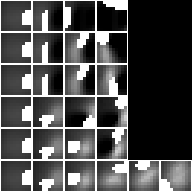
Both the averaged slice and the fud underlying are shown in each image to indicate where the attention is during decomposition.
Now showing just the averaged slice,
bmwrite(file,ppbm2(uu,vvk,10,3,2,pp))
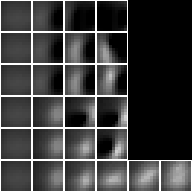
Model 6 - Square regions of 10x10 pixels
Now consider a compiled inducer. NIST_model6.json is induced by NIST_engine6.py. The sample is the entire training set of 60,000 events.
The first section loads the sample,
(uu,hr) = nistTrainBucketedRegionRandomIO(2,10,17)
The parameters are defined,
model = "NIST_model6"
(wmax,lmax,xmax,omax,bmax,mmax,umax,pmax,fmax,mult,seed) = (2**11, 8, 2**10, 30, (30*3), 3, 2**8, 1, 127, 1, 5)
The engine runs on a Python 3.5 64-bit on a Ubuntu 16.04 Intel(R) Xeon(R) Platinum 8175M CPU @ 2.50GHz using 1456MB in 20338 seconds.
The statistics are,
model cardinality: 3842
train size: 7500
alignment: 158224.09
alignment density: 78504.47
Imaging the fud decomposition,

Now with the fud underlying superimposed on the averaged slice,

Model 21 - Square regions of 15x15 pixels
Now consider a compiled inducer. NIST_model21.json is induced by NIST_engine21.py. The sample is the entire training set of 60,000 events.
The first section loads the sample,
(uu,hr) = nistTrainBucketedRegionRandomIO(2,15,17)
The parameters are defined,
model = "NIST_model21"
(wmax,lmax,xmax,omax,bmax,mmax,umax,pmax,fmax,mult,seed) = (2**11, 8, 2**10, 30, (30*3), 3, 2**8, 1, 127, 1, 5)
The engine runs on a Python 3.5 64-bit on a Ubuntu 16.04 Intel(R) Xeon(R) Platinum 8175M CPU @ 2.50GHz using 1728 MB in 23497 seconds.
The statistics are,
model cardinality: 4082
train size: 7500
alignment: 195132.96
alignment density: 97210.93
Imaging the fud decomposition,

Now with the fud underlying superimposed on the averaged slice,

Model 10 - Centred square regions of 11x11 pixels
NIST_model10.json is induced by NIST_engine10.py. The sample is the entire training set of 60,000 events.
The first section loads the sample,
(uu,hrtr) = nistTrainBucketedRegionRandomIO(2,11,17)
u = stringsVariable("<6,6>")
hr = hrhrsel(hrtr,aahr(uu,single(llss([(u,ValInt(1))]),1)))
digit = VarStr("digit")
vv = uvars(uu)
vvl = sset([digit])
vvk = vv - vvl
Then the parameters are defined,
model = "NIST_model10"
(wmax,lmax,xmax,omax,bmax,mmax,umax,pmax,fmax,mult,seed) = (2**11, 8, 2**10, 30, (30*3), 3, 2**8, 1, 127, 1, 5)
The engine runs on a Python 3.5 64-bit on a Ubuntu 16.04 Intel(R) Xeon(R) Platinum 8175M CPU @ 2.50GHz using 1094 MB in 17678 seconds.
The statistics are,
model cardinality: 3711
train size: 2311
alignment: 53897.90
alignment density: 26846.93
Imaging the fud decomposition,

Now with the fud underlying superimposed on the averaged slice,

Model 24 - Two level over 10x10 regions
Now consider 5x5 copies of the Model 6 - Square regions of 10x10 pixels over the whole query substrate. NIST_model24.json is induced by NIST_engine24.py. The sample is the entire training set of 60,000 events.
The first section loads the underlying sample,
(uu,hr) = nistTrainBucketedRegionRandomIO(2,10,17)
Then the underlying decomposition is loaded, reduced, converted to a nullable fud, and reframed at level 1,
df1 = dfIO('./NIST_model6.json')
uu1 = uunion(uu,fsys(dfff(df1)))
ff1 = fframe(refr1(1),dfnul(uu1,dfred(uu1,df1,hr),1))
where
def refr1(k):
def refr1_f(v):
if isinstance(v, VarPair):
(w,i) = v._rep
if isinstance(w, VarPair):
(f,l) = w._rep
if isinstance(f, VarInt):
return VarPair((VarPair((VarPair((VarPair((VarInt(k),f)),VarInt(0))),l)),i))
elif isinstance(f, VarPair):
(f1,g) = f._rep
return VarPair((VarPair((VarPair((VarPair((VarInt(k),f1)),g)),l)),i))
return v
return refr1_f
Then the sample is loaded,
(uu,hr) = nistTrainBucketedIO(2)
digit = VarStr("digit")
vv = uvars(uu)
vvl = sset([digit])
vvk = vv - vvl
Then the underlying model is copied and reframed at level 2,
gg1 = sset()
for x in [2,6,10,14,18]:
for y in [2,6,10,14,18]:
gg1 |= fframe(refr2(x,y),ff1)
uu1 = uunion(uu,fsys(gg1))
where
def refr2(x,y):
def refr2_f(v):
if isinstance(v, VarPair) and isinstance(v._rep[0], VarInt) and isinstance(v._rep[1], VarInt):
(i,j) = v._rep
return VarPair((VarInt((x-1)+i._rep),VarInt((y-1)+j._rep)))
return VarPair((v,VarStr("(" + str(x) + ";" + str(y) + ")")))
return refr2_f
Then the parameters are defined,
model = "NIST_model24"
(wmax,lmax,xmax,omax,bmax,mmax,umax,pmax,fmax,mult,seed) = (2**11, 8, 2**10, 30, (30*3), 3, 2**8, 1, 127, 1, 5)
Then the decomper is run,
(uu2,df2) = decomperIO(uu1,gg1,hr,wmax,lmax,xmax,omax,bmax,mmax,umax,pmax,fmax,mult,seed)
where
def decomperIO(uu,ff,hr,wmax,lmax,xmax,omax,bmax,mmax,umax,pmax,fmax,mult,seed):
return parametersSystemsHistoryRepasDecomperLevelMaxRollByMExcludedSelfHighestFmaxIORepa(wmax,lmax,xmax,omax,bmax,mmax,umax,pmax,fmax,mult,seed,uu,sdict([((wmax,sset(),ff),emptyTree())]),hr)
The engine runs on a Python 3.5 64-bit on a Ubuntu 16.04 Intel(R) Xeon(R) Platinum 8175M CPU @ 2.50GHz using 12663 MB in 67664 seconds.
The statistics are,
model cardinality: 5966
train size: 7500
alignment: 190022.26
alignment density: 89892.41
Imaging the fud decomposition,

Now with the fud underlying superimposed on the averaged slice,

Model 25 - Two level over 15x15 regions
Now consider 5x5 copies of the Model 21 - Square regions of 15x15 pixels over the whole query substrate. NIST_model25.json is induced by NIST_engine25.py. The sample is the entire training set of 60,000 events.
The engine is very similar to Model 24 - Two level over 10x10 regions. The first section loads the underlying sample,
(uu,hr) = nistTrainBucketedRegionRandomIO(2,15,17)
Then the underlying decomposition is loaded, reduced, converted to a nullable fud, and reframed at level 1,
df1 = dfIO('./NIST_model21.json')
uu1 = uunion(uu,fsys(dfff(df1)))
ff1 = fframe(refr1(1),dfnul(uu1,dfred(uu1,df1,hr),1))
Then the sample is loaded,
(uu,hr) = nistTrainBucketedIO(2)
digit = VarStr("digit")
vv = uvars(uu)
vvl = sset([digit])
vvk = vv - vvl
Then the underlying model is copied and reframed at level 2,
gg1 = sset()
for x in [1,4,7,10,13]:
for y in [1,4,7,10,13]:
gg1 |= fframe(refr2(x,y),ff1)
uu1 = uunion(uu,fsys(gg1))
Then the parameters are defined,
model = "NIST_model25"
(wmax,lmax,xmax,omax,bmax,mmax,umax,pmax,fmax,mult,seed) = (2**11, 8, 2**10, 30, (30*3), 3, 2**8, 1, 127, 1, 5)
Then the decomper is run,
(uu2,df2) = decomperIO(uu1,gg1,hr,wmax,lmax,xmax,omax,bmax,mmax,umax,pmax,fmax,mult,seed)
The engine runs on a Python 3.5 64-bit on a Ubuntu 16.04 Intel(R) Xeon(R) Platinum 8175M CPU @ 2.50GHz using 12349MB in 52735 seconds.
The statistics are,
model cardinality: 5787
train size: 7500
alignment: 174749.41
alignment density: 78155.56
Imaging the fud decomposition,

Now with the fud underlying superimposed on the averaged slice,

Model 26 - Two level over centred square regions of 11x11 pixels
Now consider 5x5 copies of the Model 10 - Centred square regions of 11x11 pixels over the whole query substrate. NIST_model26.json is induced by NIST_engine26.py. The sample is the entire training set of 60,000 events.
The engine is very similar to Model 24 - Two level over 10x10 regions and Model 25 - Two level over 15x15 regions. The first section loads the underlying sample,
(uu,hr) = nistTrainBucketedRegionRandomIO(2,11,17)
Then the underlying decomposition is loaded, reduced, converted to a nullable fud, and reframed at level 1,
df1 = dfIO('./NIST_model10.json')
uu1 = uunion(uu,fsys(dfff(df1)))
ff1 = fframe(refr1(1),dfnul(uu1,dfred(uu1,df1,hr),1))
Then the sample is loaded,
(uu,hr) = nistTrainBucketedIO(2)
digit = VarStr("digit")
vv = uvars(uu)
vvl = sset([digit])
vvk = vv - vvl
Then the underlying model is copied and reframed at level 2,
gg1 = sset()
for x in [1,4,7,10,13]:
for y in [1,4,7,10,13]:
gg1 |= fframe(refr2(x,y),ff1)
uu1 = uunion(uu,fsys(gg1))
Then the parameters are defined,
model = "NIST_model26"
(wmax,lmax,xmax,omax,bmax,mmax,umax,pmax,fmax,mult,seed) = (2**11, 8, 2**10, 30, (30*3), 3, 2**8, 1, 127, 1, 5)
Then the decomper is run,
(uu2,df2) = decomperIO(uu1,gg1,hr,wmax,lmax,xmax,omax,bmax,mmax,umax,pmax,fmax,mult,seed)
The engine runs in Python 3.5 64-bit on a Ubuntu 16.04 Intel(R) Xeon(R) Platinum 8175M CPU @ 2.50GHz using 9280MB in 56259 seconds.
The statistics are,
model cardinality: 5671
train size: 7500
alignment: 206488.07
alignment density: 98883.55
Imaging the fud decomposition,
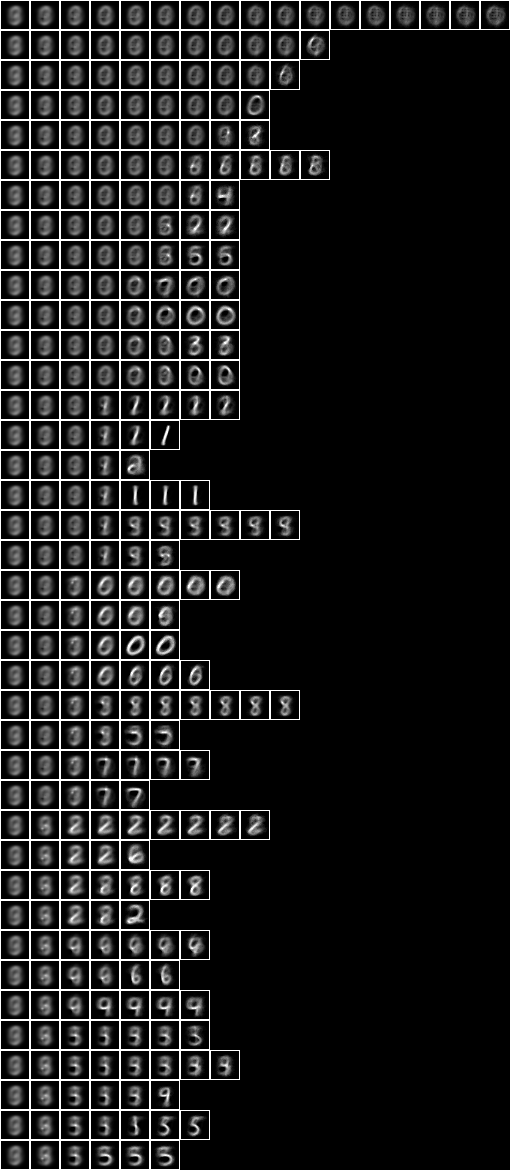
Now with the fud underlying superimposed on the averaged slice,
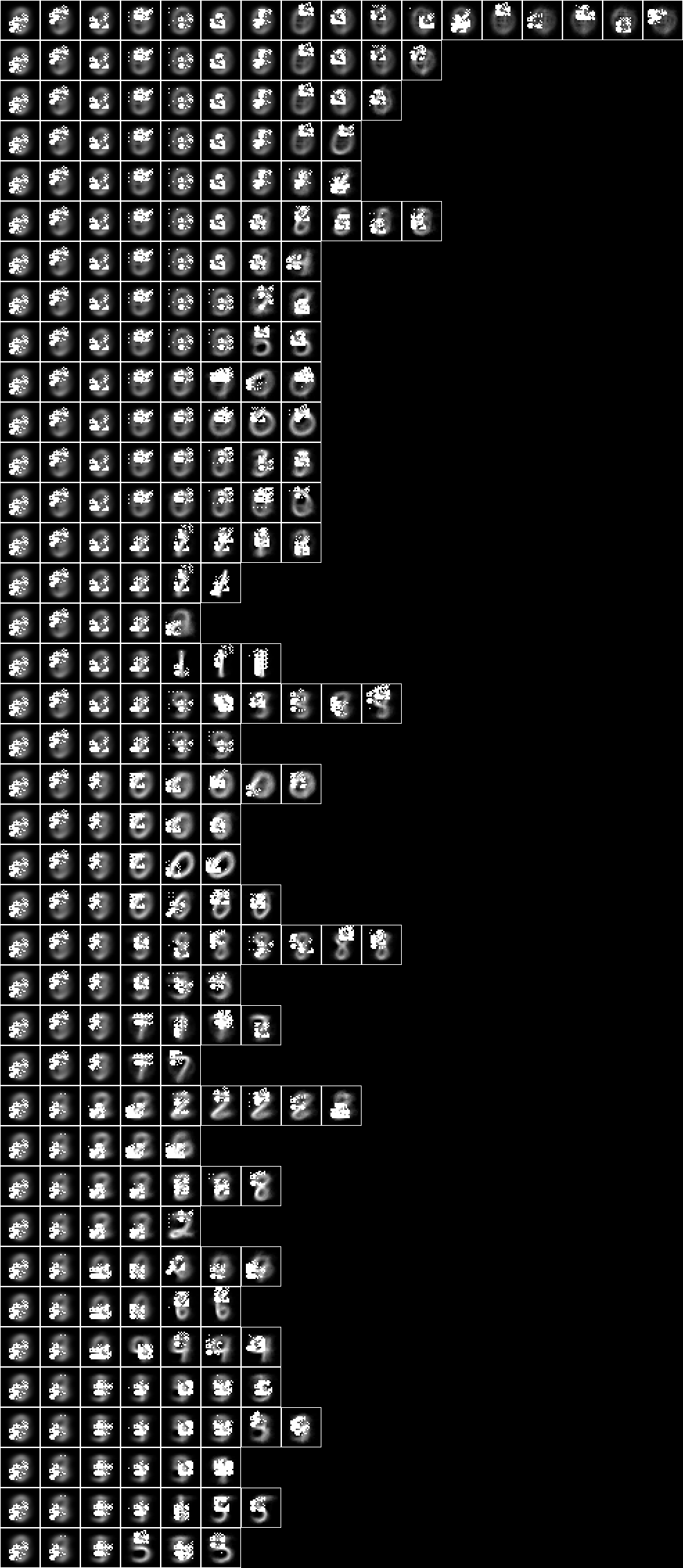
NIST test
The NIST_test.py is executed as follows,
python3 NIST_test.py NIST_model2
model: NIST_model2
train size: 7500
model cardinality: 515
nullable fud cardinality: 688
nullable fud derived cardinality: 147
nullable fud underlying cardinality: 134
ff label ent: 1.4174827406154242
test size: 1000
effective size: 988
matches: 436
This runs on model 2 in a Python 3.5 64-bit interpreter on a Ubuntu 16.04 Intel(R) Xeon(R) Platinum 8175M CPU @ 2.50GHz in 270 seconds.
The first section loads the sample and the model,
model = argv[1]
(uu,hrtr) = nistTrainBucketedIO(2)
hr = hrev([i for i in range(hrsize(hrtr)) if i % 8 == 0],hrtr)
digit = VarStr("digit")
vv = uvars(uu)
vvl = sset([digit])
vvk = vv - vvl
df1 = dfIO(model + '.json')
Then the fud decomposition fud is created,
uu1 = uunion(uu,fsys(dfff(df1)))
ff1 = dfnul(uu1,df1,9)
Then the label entropy is calculated,
uu1 = uunion(uu,fsys(ff1))
hr1 = hrfmul(uu1,ff1,hr)
print("ff label ent: %.16f" % hrlent(uu1,hr1,fder(ff1),vvl))
Lastly, the test history is loaded and the query effectiveness and query accuracy is calculated,
(uu,hrte) = nistTestBucketedIO(2)
hrq = hrev([i for i in range(hrsize(hrte)) if i % 10 == 0],hrte)
hrq1 = hrfmul(uu1,ff1,hrq)
print("effective size: %d" % int(size(mul(hhaa(hrhh(uu1,hrhrred(hrq1,fder(ff1)))),eff(hhaa(hrhh(uu1,hrhrred(hr1,fder(ff1)))))))))
print("matches: %d" % len([rr for (_,ss) in hhll(hrhh(uu1,hrhrred(hrq1,fder(ff1)|vvl))) for qq in [single(ss,1)] for rr in [araa(uu1,hrred(hrhrsel(hr1,hhhr(uu1,aahh(red(qq,fder(ff1))))),vvl))] if size(rr) > 0 and size(mul(amax(rr),red(qq,vvl))) > 0]))
NIST conditional
Given an induced model, this engine finds a semi-supervised submodel that predicts the label variables, $V_{\mathrm{l}}$, or digit, by optimising conditional entropy. The NIST_engine_cond.py is defined as follows.
The first section loads the parameters, sample and the model,
valency = int(argv[1])
modelin = argv[2]
kmax = int(argv[3])
omax = int(argv[4])
fmax = int(argv[5])
model = argv[6]
(uu,hr) = nistTrainBucketedIO(valency)
digit = VarStr("digit")
vv = uvars(uu)
vvl = sset([digit])
vvk = vv - vvl
df1 = dfIO(modelin + '.json')
Then the fud decomposition fud is created,
uu1 = uunion(uu,fsys(dfff(df1)))
ff1 = fframe(refr1(3),dfnul(uu1,df1,1))
Then the model is applied,
uu1 = uunion(uu,fsys(ff1))
hr1 = hrfmul(uu1,ff1,hr)
Then the conditional entropy fud decomper is run,
(uu2,df2) = decompercondrr(vvl,uu1,hr1,kmax,omax,fmax)
df21 = zzdf(funcsTreesMap(lambda xx:(xx[0],fdep(xx[1]|ff1,fder(xx[1]))),dfzz(df2)))
where
def decompercondrr(ll,uu,aa,kmax,omax,fmax):
return parametersSystemsHistoryRepasDecomperConditionalFmaxRepa(kmax,omax,fmax,uu,ll,aa)
Then the model is written to NIST_model36.json,
open(model+".json","w").write(decompFudsPersistentsEncode(decompFudsPersistent(df21)))
Finally the images are written out,
pp = treesPaths(hrmult(uu2,df21,hr1))
bmwrite(model+".bmp",ppbm2(uu,vvk,28,1,2,pp))
bmwrite(model+"_1.bmp",ppbm(uu,vvk,28,1,2,pp))
bmwrite(model+"_2.bmp",ppbm(uu,vvk,28,2,2,pp))
Model 36 - Conditional level over 15-fud
Now run the conditional entropy fud decomper to create Model 36, the conditional level over 15-fud induced model of all pixels, Model 2,
python3 NIST_engine_cond.py 2 NIST_model2 1 5 15 NIST_model36 >NIST_engine36.log
This runs on on a Ubuntu 16.04 Pentium CPU G2030 @ 3.00GHz in 1883 MB memory in 231 seconds.
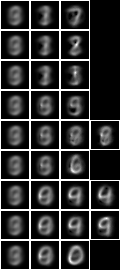
Now with the fud underlying superimposed on the averaged slice,
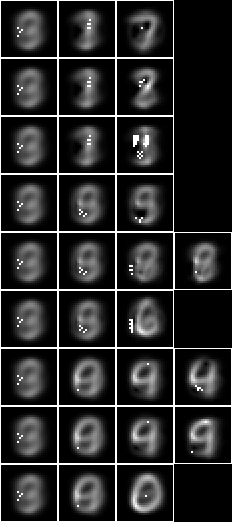
If we run NIST test on the new model,
python3 NIST_test.py NIST_model36 >NIST_test_model36.log
we obtain the following statistics,
model: NIST_model36
train size: 7500
model cardinality: 162
nullable fud cardinality: 202
nullable fud derived cardinality: 15
nullable fud underlying cardinality: 63
ff label ent: 1.4004486362258195
test size: 1000
effective size: 1000
matches: 507
Model 37 - Conditional level over all pixels
Now let us repeat the analysis of Model 36, but for the conditional level over 127-fud induced model of all pixels, Model 35. Model 37 -
python3 NIST_engine_cond.py 2 NIST_model35 1 5 127 NIST_model37 >NIST_engine37.log
The engine runs on a Python 3.5 64-bit on a Ubuntu 16.04 Intel(R) Xeon(R) Platinum 8175M CPU @ 2.50GHz using 12462 MB in 5497 seconds.

Now with the fud underlying superimposed on the averaged slice,

If we run NIST test on the new model,
python3 NIST_test.py NIST_model37 >NIST_test_model37.log
we obtain the following statistics,
model: NIST_model37
train size: 7500
model cardinality: 663
nullable fud cardinality: 1039
nullable fud derived cardinality: 127
nullable fud underlying cardinality: 253
ff label ent: 0.6564998305260028
test size: 1000
effective size: 999
matches: 773
Repeating the same, but with 2-tuple conditional,
python3 NIST_engine_cond.py 2 NIST_model35 2 5 127 NIST_model39 >NIST_engine39.log
The engine runs on a Python 3.5 64-bit on a Ubuntu 16.04 Intel(R) Xeon(R) Platinum 8175M CPU @ 2.50GHz using 9281 MB in 10614 seconds.

Now with the fud underlying superimposed on the averaged slice,

If we run NIST test on the new model,
python3 NIST_test.py NIST_model39 >NIST_test_model39.log
we obtain the following statistics,
model: NIST_model39
train size: 7500
model cardinality: 872
nullable fud cardinality: 1242
nullable fud derived cardinality: 127
nullable fud underlying cardinality: 301
ff label ent: 0.4036616947586324
test size: 1000
effective size: 979
matches: 797
Model 38 - Conditional level over averaged pixels
Now let us repeat the analysis for the conditional level over 127-fud induced model of averaged pixels, Model 34.
The NIST_engine_cond_averaged.py is defined as follows. The first section loads the parameters, sample and the model,
valency = int(argv[1])
breadth = int(argv[2])
offset = int(argv[3])
modelin = argv[4]
kmax = int(argv[5])
omax = int(argv[6])
fmax = int(argv[7])
model = argv[8]
(uu,hr) = nistTrainBucketedAveragedIO(valency,breadth,offset)
digit = VarStr("digit")
vv = uvars(uu)
vvl = sset([digit])
vvk = vv - vvl
df1 = dfIO(modelin + '.json')
The remainder is as for Model 36.
Now run Model 38 -
python3 NIST_engine_cond_averaged.py 8 9 0 NIST_model34 1 5 127 NIST_model38 >NIST_engine38.log
The engine runs on a Python 3.5 64-bit on a Ubuntu 16.04 Intel(R) Xeon(R) Platinum 8175M CPU @ 2.50GHz using 10847 MB in 5517 seconds.

Now with the fud underlying superimposed on the averaged slice,

NIST test averaged
We must modify NIST test to allow for an averaged substrate. The NIST_test_averaged.py is executed as follows,
python3 NIST_test_averaged.py 8 9 0 NIST_model38 >NIST_test_model38.log
we obtain the following statistics,
model: NIST_model38
selected train size: 7500
model cardinality: 308
nullable fud cardinality: 683
nullable fud derived cardinality: 127
nullable fud underlying cardinality: 45
ff label ent: 0.6309812112866986
test size: 1000
effective size: 986
matches: 718
NIST conditional over square regions
We can modify NIST conditional to copy an array of region models. The NIST_engine_cond_regions.py is defined follows, The first section loads the parameters, regional sample and the regional model,
valency = int(argv[1])
breadth = int(argv[2])
seed = int(argv[3])
ufmax = int(argv[4])
locations = map(int, argv[5].split())
modelin = argv[6]
kmax = int(argv[7])
omax = int(argv[8])
fmax = int(argv[9])
model = argv[10]
(uu,hr) = nistTrainBucketedRegionRandomIO(valency,breadth,seed)
df1 = dfIO(modelin + '.json')
Then the fud decomposition fud is created,
uu1 = uunion(uu,fsys(dfff(df1)))
ff1 = fframe(refr1(3),dfnul(uu1,dflt(df1,ufmax),3)))
Then the sample is loaded,
(uu,hr) = nistTrainBucketedIO(valency)
digit = VarStr("digit")
vv = uvars(uu)
vvl = sset([digit])
vvk = vv - vvl
Then the model is copied,
gg1 = sset()
for x in locations:
for y in locations:
gg1 |= fframe(refr2(x,y),ff1)
Then the model is applied,
uu1 = uunion(uu,fsys(gg1))
hr1 = hrfmul(uu1,gg1,hr)
Then the conditional entropy fud decomper is run,
(uu2,df2) = decompercondrr(vvl,uu1,hr1,kmax,omax,fmax)
df21 = zzdf(funcsTreesMap(lambda xx:(xx[0],fdep(xx[1]|gg1,fder(xx[1]))),dfzz(df2)))
where
def decompercondrr(ll,uu,aa,kmax,omax,fmax):
return parametersSystemsHistoryRepasDecomperConditionalFmaxRepa(kmax,omax,fmax,uu,ll,aa)
The remainder of the engine is as for NIST conditional.
Model 43 - Conditional level over square regions of 15x15 pixels
Now run the regional conditional entropy fud decomper to create Model 43, the conditional level over a 7x7 array of 127-fud induced models of square regions of 15x15 pixels, Model 21,
python3 NIST_engine_cond_regions.py 2 15 17 31 "1 3 5 7 9 11 13" NIST_model21 1 5 127 NIST_model43 >NIST_engine43.log
The engine runs on a Python 3.5 64-bit on a Ubuntu 16.04 Intel(R) Xeon(R) Platinum 8175M CPU @ 2.50GHz using 1546 MB in 7129 seconds.

Now with the fud underlying superimposed on the averaged slice,

If we run NIST test on the new model,
python3 NIST_test.py NIST_model43 >NIST_test_model43.log
we obtain the following statistics,
model: NIST_model43
train size: 7500
model cardinality: 868
nullable fud cardinality: 1244
nullable fud derived cardinality: 127
nullable fud underlying cardinality: 218
ff label ent: 0.6758031753055889
test size: 1000
effective size: 999
matches: 770
Model 40 - Conditional level over two level over 10x10 regions
Now run the conditional entropy fud decomper over the 2-level induced model Model 24 to create Model 40,
python3 NIST_engine_cond.py 2 NIST_model24 1 5 127 NIST_model40 >NIST_engine40.log
The engine runs on a Python 3.5 64-bit on a Ubuntu 16.04 Intel(R) Xeon(R) Platinum 8175M CPU @ 2.50GHz using 17084 MB in 33159 seconds.

Now with the fud underlying superimposed on the averaged slice,

If we run NIST test on the new model,
python3 NIST_test.py NIST_model40 >NIST_test_model40.log
we obtain the following statistics,
model: NIST_model40
train size: 7500
model cardinality: 2140
nullable fud cardinality: 2516
nullable fud derived cardinality: 127
nullable fud underlying cardinality: 562
ff label ent: 0.5836689910897102
test size: 1000
effective size: 997
matches: 802
Model 41 - Conditional level over two level over 15x15 regions
Now run the conditional entropy fud decomper over the 2-level induced model Model 25 to create Model 41,
python3 NIST_engine_cond.py 2 NIST_model25 1 5 127 NIST_model41 >NIST_engine41.log
The engine runs on a Python 3.5 64-bit on a Ubuntu 16.04 Intel(R) Xeon(R) Platinum 8175M CPU @ 2.50GHz using 14880 MB in 8067 seconds.

Now with the fud underlying superimposed on the averaged slice,

If we run NIST test on the new model,
python3 NIST_test.py NIST_model41 >NIST_test_model41.log
we obtain the following statistics,
model: NIST_model41
train size: 7500
model cardinality: 1264
nullable fud cardinality: 1639
nullable fud derived cardinality: 127
nullable fud underlying cardinality: 421
ff label ent: 0.5874380803591093
test size: 1000
effective size: 998
matches: 778
Model 42 - Conditional level over centred square regions of 11x11 pixels
Now run the conditional entropy fud decomper over the 2-level induced model Model 26 to create Model 42,
python3 NIST_engine_cond.py 2 NIST_model26 1 5 127 NIST_model42 >NIST_engine42.log
The engine runs on a Python 3.5 64-bit on a Ubuntu 16.04 Intel(R) Xeon(R) Platinum 8175M CPU @ 2.50GHz using 16430 MB in 10313 seconds.

Now with the fud underlying superimposed on the averaged slice,

If we run NIST test on the new model,
python3 NIST_test.py NIST_model42 >NIST_test_model42.log
we obtain the following statistics,
model: NIST_model42
train size: 7500
model cardinality: 772
nullable fud cardinality: 1149
nullable fud derived cardinality: 127
nullable fud underlying cardinality: 274
ff label ent: 0.6004072422056215
test size: 1000
effective size: 1000
matches: 785